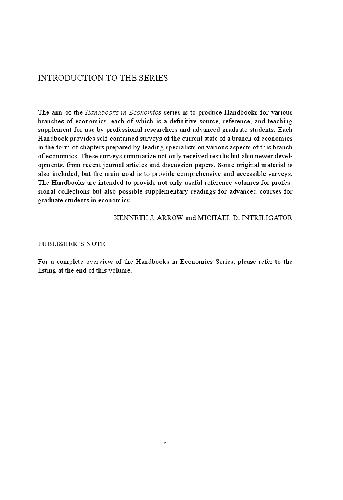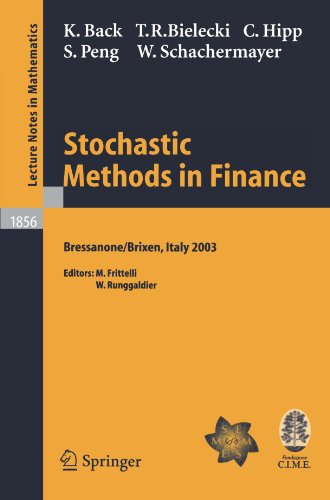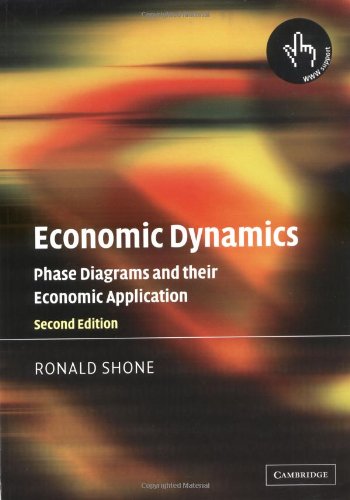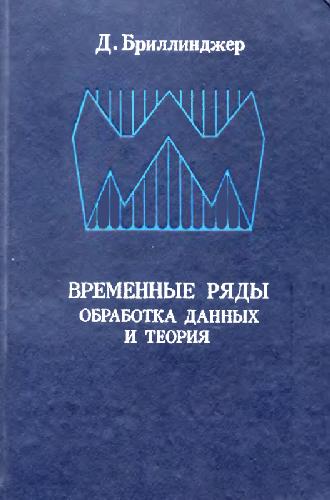Karl-Göran Mäler, Jeffrey R. Vincent9780080457499, 9780444511454, 0444511458
Table of contents :
1.pdf……Page 1
2.pdf……Page 2
Allen Kneese……Page 6
4.pdf……Page 7
Acknowledgements……Page 11
5.pdf……Page 13
Welfare Theory and Valuation……Page 21
Keywords……Page 22
Introduction……Page 23
The nature of economic value……Page 24
Overview of the environmental valuation problem……Page 26
Defining a measure of welfare change……Page 29
Price changes……Page 32
Toward measurement……Page 34
Changes in environmental quality……Page 36
Uncertainty and risk……Page 38
Aggregation and social welfare……Page 39
Revealed preference methods……Page 42
Stated preference methods……Page 43
Revealed preference methods for estimating values……Page 44
A taxonomy of models……Page 45
Perfect substitution……Page 46
Imperfect substitution……Page 48
Defensive expenditures……Page 49
Applications to human health effects……Page 50
Complementary relationships……Page 53
Why the weak complementarity restriction is so useful……Page 54
Weak complementarity in a household model……Page 57
Exploiting other relationships, including weak neutrality……Page 59
Welfare in a discrete choice context……Page 60
Hedonic models……Page 62
Hedonic property value models……Page 63
Hedonic wage models……Page 65
Use and nonuse values……Page 67
References……Page 70
Environment, Uncertainty, and Option Values……Page 75
Abstract……Page 76
Keywords……Page 77
Introduction……Page 78
The basic framework……Page 79
Risk aversion……Page 80
The value of changes in risk……Page 81
Aggregation over individuals……Page 84
The cost of risk bearing……Page 86
Option prices and option values……Page 89
Price uncertainty……Page 91
Introduction……Page 93
A simple two-period model……Page 94
An empirical application: to develop or to preserve……Page 97
Bayesian updating……Page 99
Information structures……Page 100
Irreversibility……Page 102
Irreversibility at a cost……Page 105
The value of information……Page 108
Uncertainty about irreversibility……Page 109
Option values……Page 111
Investment under uncertainty……Page 113
Optimal stopping……Page 115
Continuous time and stochastic processes……Page 116
An application: when to cut an old-growth redwood forest……Page 118
on the equivalence of two representations of environmental changes……Page 120
a different notion of “more informative”……Page 121
References……Page 122
Further reading……Page 123
Valuing the Environment as a Factor of Production……Page 125
Keywords……Page 126
Introduction……Page 127
The context of the problem……Page 129
The individual or household’s decision problem……Page 130
The firm’s decision process……Page 132
Issues of scale, interactions, and complexities……Page 134
The environment affects the firm’s production opportunities……Page 139
The single output firm……Page 140
The multiple output firm……Page 142
Using input demand functions……Page 144
Valuing changes in output using a damage function……Page 146
Valuing actual changes in output……Page 149
Further complications……Page 151
Price changes and multiple markets……Page 152
Instability and uncertainty……Page 153
Market distortions……Page 154
Environmental inputs and open access resources: the case of the fishery……Page 155
Environmental influences on forestry productivity……Page 159
Separable production and consumption……Page 161
When production and utility maximization are nonseparable……Page 162
Can the demand for the household produced good be estimated?……Page 165
Averting behavior by the household……Page 166
Conclusions……Page 169
References……Page 170
Recreation Demand Models……Page 174
Keywords……Page 175
Introduction……Page 176
Recreation and consumer expenditures……Page 177
Preferences for recreation……Page 179
Policy impacts……Page 184
Modeling preferences……Page 186
An “ideal” implementation of the basic model……Page 194
Single equation and demand system travel cost models……Page 196
Random utility and related models……Page 199
Corner solution models……Page 215
Price index models……Page 218
Overall prognosis on the modeling strategies……Page 219
Recreation data……Page 220
Data collection as an economic process……Page 221
Combining revealed and stated preference data……Page 222
Linking site characteristics to behavioral data……Page 225
Measuring travel distances and costs……Page 227
Single site demand models……Page 228
Systems of recreation demand equations……Page 231
Random utility models……Page 234
Dynamic models……Page 237
Nonparametric methods and models……Page 239
Price versus quality changes……Page 242
Valuation measures with extensive margin choices and unobserved heterogeneity……Page 245
Research ahead……Page 248
References……Page 254
Property Value Models……Page 265
Keywords……Page 266
Introduction……Page 267
The theory of consumer behavior in markets for differentiated products……Page 268
Discrete choice models……Page 274
Localized externalities……Page 276
Nonlocalized externalities without moving……Page 277
Nonlocalized externalities with moving……Page 284
Estimating the hedonic price schedule……Page 285
Extent of the market……Page 286
Functional form……Page 287
Nonparametric and semiparametric estimation……Page 288
Measurement of the environmental variables……Page 291
Other specification issues……Page 292
Spatial econometric techniques……Page 293
Rental prices vs. asset prices……Page 296
Timing of environmental impacts……Page 297
Repeat sales……Page 298
Search costs and time on the market……Page 299
Identification……Page 300
Endogeneity……Page 302
Random utility models……Page 304
Random bidding models……Page 308
Locational equilibrium models……Page 310
Conclusions and directions for future research……Page 312
Appendix A……Page 313
References……Page 315
Contingent Valuation……Page 322
Abstract……Page 323
Keywords……Page 324
Introduction……Page 325
Antecedents and beginnings……Page 328
Early empirical development……Page 330
Health, transportation, and the allocation of public budgets……Page 334
The existence value revolution……Page 336
Developments from the mid-1970s through the late 1980s……Page 338
The Mitchell and Carson book……Page 340
Exxon Valdez……Page 341
Literature production……Page 342
Major issues……Page 344
Economic welfare measures……Page 345
From WTP to CV response……Page 348
Statistical model of CV responses……Page 352
Summary measures of welfare……Page 358
Existence value……Page 363
Combining CV and RP data to measure use versus nonuse value……Page 366
Contingent behavior……Page 367
Option value……Page 368
Elicitation formats for stated preference information……Page 370
Response probability models for alternative elicitation formats……Page 374
The issue of incentive compatibility……Page 376
Some general results on incentives……Page 377
A typology of the incentive structure of elicitation formats……Page 382
Promoting incentive compatibility……Page 384
Structure of WTP distributions……Page 385
Issues in fitting binary discrete choice models……Page 388
Bid design……Page 390
Treatment of don’t knows and protest zeros……Page 391
Treatment of respondent uncertainty……Page 392
Continuous response CV data……Page 394
Choice experiments……Page 395
Survey design……Page 398
Defining the population of interest……Page 402
Survey mode……Page 403
Sampling approaches……Page 404
Nonresponse……Page 405
Sample size……Page 406
Neoclassical theory and contingent valuation……Page 407
WTP versus WTA……Page 408
Income elasticity of WTP……Page 409
Sequencing, nesting, scope insensitivity and the adding-up test……Page 411
Consistency of CV results with actual behavior……Page 415
Concluding remarks……Page 419
References……Page 421
Cognitive Processes in Stated Preference Methods……Page 438
Keywords……Page 439
Overview……Page 440
History……Page 441
Design framework……Page 442
Evaluative extensions……Page 444
Decision theory stream……Page 446
Confluence……Page 449
Psychophysics stream……Page 450
Decision theory stream……Page 453
A cognitive approach to eliciting stated preferences for environmental outcomes……Page 457
Contingent valuation: a postscript……Page 464
References……Page 465
Experimental Methods and Valuation……Page 470
Keywords……Page 471
Introduction……Page 472
The experimental method and mindset……Page 473
Methods to establish rational valuation……Page 481
The divergence between WTP and WTA……Page 482
Preference reversals……Page 486
Synopsis on rational valuation……Page 492
Methods to measure values……Page 494
Experiments valuing public goods……Page 495
Experiments valuing private risks……Page 498
Does the unique lab environment inflate values?……Page 499
How does external information affect bidding behavior?……Page 500
How do lab choices compare to retail market behavior?……Page 502
Does the risk reduction mechanism matter?……Page 503
Synopsis on direct valuation……Page 504
Hypothetical bias I: does it exist?……Page 506
Hypothetical bias II: calibration……Page 508
Framing effects I: surrogate bidding (scope/embedding)……Page 511
Framing II: incentive compatibility……Page 514
Synopsis on testbedding……Page 517
Concluding remarks……Page 519
References……Page 521
Quantifying and Valuing Environmental Health Risks……Page 529
Keywords……Page 530
Introduction……Page 531
Historical background and current regulatory guidelines in the U.S…….Page 532
Hazard identification……Page 534
Dose-response assessment……Page 537
Exposure assessment……Page 539
Risk assessment in other countries……Page 541
Conservative risk assessment practices……Page 545
Synthetic v. natural chemicals……Page 550
Actual v. perceived risk……Page 551
The value of a statistical life v. the human capital approach……Page 558
Valuing morbidity risks……Page 560
The hedonic wage model……Page 563
The empirical specification of the hedonic wage equation……Page 566
Accounting for the duration and quality of life……Page 568
Labor market evidence of risk tradeoffs……Page 570
Survey evidence of risk tradeoffs……Page 573
Risk tradeoffs in other countries……Page 576
Using housing market data to estimate the value of a statistical cancer case……Page 579
Regulatory performance……Page 581
Legislative mandates, judicial review, and executive oversight in the U.S…….Page 588
Risk-risk analysis……Page 590
Moral hazard and forgone health benefits……Page 591
The opportunity costs of risk-reduction regulations……Page 592
Conclusion……Page 596
References……Page 597
15.pdf……Page 604
16.pdf……Page 625







Reviews
There are no reviews yet.